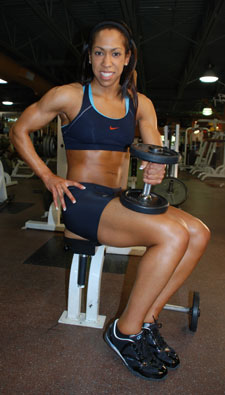|
Training Frequency - How Often Can You
or SHOULD You Train To Maximize Your Results?
 One of the most basic questions in weight training is "how many times a week should I train for best results?" EVERYBODY has wondered this at some point in their training career, from the complete beginner to the most advanced professional.
One of the most basic questions in weight training is "how many times a week should I train for best results?" EVERYBODY has wondered this at some point in their training career, from the complete beginner to the most advanced professional.
The answer could very well change the way you train forever!
And the answer is simple... it depends!
Now, this is an answer that ALWAYS leads immediately to the next question... depends on what?
At this point, most instructors or training manuals will go right to the stock response of "train each bodypart twice a week" or something to that effect. It's easy to believe that this is the best answer because that generally works okay for most people. It's a safe answer.
But it's not the BEST answer. Learning what IS the best answer will help you cast out preconceived notions and determine what REALLY works best for your body.
There are a number of factors that influence how often you should train your muscles. Each single factor plays a part in how often you should train and they ALL interact with each other. I will go through the factors then give you real-world examples of how these factors come together to help you determine how often you should train.
1. Training Volume
Training volume is basically how much you are doing for each bodypart. It's the number of reps and the number of sets you are doing.
The more sets you do for a bodypart, the less frequently you should train the bodypart to give it a chance to recover. If you do fewer sets, you can train more frequently and recover from it.
2. Training Intensity
This is not the scientific definition of intensity (i.e. how close the weight you are using is to your one rep max for that exercise) but rather your effort intensity. Basically, it's how hard you're working your muscles.
The harder you push yourself in your sets, the less frequent your training should be as this will tax your recovery systems more strongly.
3. Nutrition
How much you eat and, more importantly, WHAT you eat plays a critical role in how often you can and should train. Don't think nutrition plays a big role in training frequency? Eat nothing but Pop Tarts for a week and see how often you're able to train...
 The higher the quality of the food you eat and, to some degree, the more food you eat, the better you'll be able to recover and the more often you'll be able to train.
The higher the quality of the food you eat and, to some degree, the more food you eat, the better you'll be able to recover and the more often you'll be able to train.
4. Recovery
When it comes to recovery, everybody is different...some people recover slowly while some recover very quickly. This difference can be heightened by outside activities and stresses to the body. For instance, a construction worker, who has a physical job, will need more recovery time than an office worker. Playing intense sports will also affect recovery ability.
Therefore, the slower your recovery rate and/or the more outside activities you do, the more time you will need between training sessions.
5. Exercise Selection
Which exercise is most demanding to the thighs and the whole body in general... a barbell squat or a leg extension? The squat, of course, because the more demanding the exercises are on a bodypart (or the whole body), the less frequently you can effectively train that bodypart.
6. Bodypart Size
The bigger the bodypart, e.g. back, thighs and chest, the more recovery time it needs. All things being equal, smaller bodyparts can be worked more frequently because they have less muscle mass that needs repair.
7. Type of Training You Do
Partials, negatives and other intensity techniques are going to affect how frequently you can effectively train a bodypart. These styles take more recovery time for the muscles and will require a decrease in training frequency.
TRAINING FREQUENCY RULES OF THUMB
These simple lists will show you the directions in which each factor will take you. All the factors interact to give you the best solution as to how often you should train.
You Can Train At a Higher Frequency If You Have:
-A better recovery rate
-Good nutrition and supplementation
-Lower training volume
-Lower training intensity
-Easier exercises
-Smaller bodyparts
-Fewer intensity techniques
You Should Train At a Lower Frequency If You Have:
-A slower recovery rate
-Poor nutrition and supplementation
-Higher training volume
-Higher training intensity
-Tougher exercises
-Larger bodyparts
-More intensity techniques
How It All Fits Together:
These are the major factors that determine optimum training frequency. Though the interaction of all these factors may seem complex, when you get right down to it, it's actually quite intuitive.
A good way to demonstrate this is by using myself as an example in different phases of training that I've been through. You will see, according to all the different factors, how I changed my training frequency and training schedules to maximize results.
You will also see that the common conceptions and "rules" that you have been told you must stick to in terms of training frequency (e.g. twice a week) are based only on simple assumptions, not on actual situations.
EXAMPLE #1 - Heavy manual labor, limited access to quality food
Because of the specific job conditions I was in at the time, I reduced the frequency of my training to three sessions per week and reduced my total training volume. I did total body workouts on each of the three days (Monday, Wednesday and Friday), using the heaviest exercises for each bodypart for 3 sets of 8 to 10 reps each (e.g. squats, bench press, bent-over rows).
 I didn't push my muscles to complete failure in my training so that I didn't beat myself down too much in addition to the heavy manual labor job.
I didn't push my muscles to complete failure in my training so that I didn't beat myself down too much in addition to the heavy manual labor job.
It was a simple program but very effective. It gave me enough recovery time because the volume was low and the intensity was moderate, even though the frequency for each bodypart was three times a week.
EXAMPLE #2 - In-home vacation, unlimited access to food and recovery, no demanding outside activities or work.
A number of years ago, I worked on cruise ships as a sports director. I would work 8 to 10 months straight (every single day) then have a few months completely off. During this time off, I had access to a gym, food and plenty of sleep.
To maximize results, I would dramatically increase my training volume and frequency and utilize intensity techniques regularly.
The catch? Since I was basically only eating, sleeping and training, I was able to recover from this high frequency and make excellent gains in strength and muscle mass.
As an extreme example of the frequency I was able to work with at this point, I was in the gym 6 days a week, twice a day, doing total-body workouts EVERY SINGLE TIME. This amounted to 12 total-body workouts a week, in addition to intensity techniques. The actual training volume (number of sets) in each workout was fairly low (3 or 4 sets per bodypart), which also allowed me to get results from that very high frequency.
Because I was able to recover from it, the high frequency of training worked in my favor and allowed me to get great results. But would I recommend this type of program to someone working a physical job or without optimum nutrition in quality or amount? No chance.
EXAMPLE #3 - Extremely busy work schedule, office job, meals determined by work breaks but workouts may have to be put off until the next day to accommodate overtime.
 Having an office job meant that it wasn't physically demanding, allowing for good recovery. Nutrition, however, was often hit-or-miss due to busy scheduling. There were times, when work demanded, that I needed to put in hours after regular time, which forced me to push workouts back to the next day.
Having an office job meant that it wasn't physically demanding, allowing for good recovery. Nutrition, however, was often hit-or-miss due to busy scheduling. There were times, when work demanded, that I needed to put in hours after regular time, which forced me to push workouts back to the next day.
To maximize the results with this situation, I changed to a "one bodypart per day" training system. I would do a single bodypart in a workout, working it with high volume and high intensity. The next day I would do a different bodypart, rotating continuously through all the major bodyparts.
Because I was working only one bodypart at a time, the training frequency was very low, basically working the target bodypart once every 7 to 8 days. This, of course, would increase if I had to bump a workout back a day.
Even though I would basically "destroy" the single bodypart in its workout, this low training frequency gave my body enough time to recover and rebuild the muscle. It would take that much time for the part to recover. Also, when you work one bodypart, other bodyparts area invariably involved, allowing for indirect stimulation of the other muscles more frequently, e.g. when you bench press for the chest, the triceps are also involved.
This plan gave me the flexibility to easily change workout schedules without compromising results while allowing my less-than-perfect nutrition to still allow me to recover enough between workouts and get results.
CONCLUSION:
As you can see, optimum training frequency is nothing as simple as "work each bodypart twice a week." The give and take between a number of different factors in your life and schedule will help you determine how often you should be training and the type of training you should be doing for best results.

More Articles by Author Nick Nilsson
Return To Weight Lifting Articles Archive
|